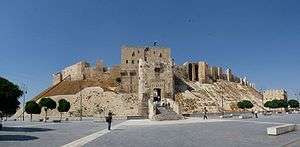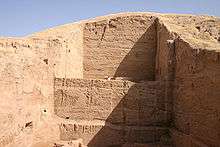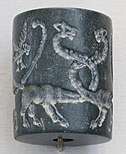Tell (archaeology)
In archaeology, a tell or tel (derived from Arabic: تَل, tall, 'mound' or 'small hill'),[1][2] is an artificial mound formed from the accumulated remains of mudbricks and other refuse of generations of people living on the same site for hundreds or thousands of years. A classic tell looks like a low, truncated cone with sloping sides[3] and can be up to 30 metres high.[4]


Tells are most commonly associated with the archaeology of the ancient Near East, but they are also found elsewhere, such as Central Asia, Eastern Europe,[5] West Africa[6] and Greece.[7][8] Within the Near East, they are concentrated in less arid regions, including Upper Mesopotamia, the Southern Levant, Anatolia and Iran, which had more continuous settlement.[4]
Etymology
Tell is derived from the Arabic word tall (تَل), meaning ‘mound’ or ‘small hill’, and is first attested in English in 1840 in a report in the Journal of the Royal Geographical Society.[1] Variant spellings include tall, tel, til, and tal.[1][9][10] The Hebrew word tel (תל) is a cognate. There are equivalents in other Southwest Asian languages, including tepe or tappeh (Turkish/Persian: تپه, also transliterated teppe and tepe), hüyük or höyük (Turkish), and chogha (Persian: چغا). These often appear in place names and are sometimes used by archaeologists to refer to the same type of sites.[9][10] The Arabic word khirbet or khirbat (خربة), meaning 'ruin', also occurs in the names of many archaeological tells.
Archaeology

A tell is an artificial hill created by many generations of people living and rebuilding on the same spot. Over time, the level rises, forming a mound.[11] The single biggest contributor to the mass of a tell are mud bricks, which disintegrate rapidly. Excavating a tell can reveal buried structures such as government or military buildings, religious shrines, and homes, located at different depths depending on their date of use. They often overlap horizontally, vertically, or both. Archaeologists excavate tell sites to interpret architecture, purpose, and date of occupation.
References
- "tell". Oxford English Dictionary (3rd ed.). Oxford University Press. September 2005. (Subscription or UK public library membership required.)
- Kirkpatrick, E. M. (1983). Chambers 20th Century Dictionary (New ed.). Edinburgh: W & R Chambers Ltd. p. 1330. ISBN 978-0-550-10234-8.
- "Archaeology of Palestine", Art of Excavating a Palestinian Mound, William Foxwell Albright, 1960, p. 16
- Wilkinson, Tony J. (2003). Archaeological Landscapes of the Near East. Tucson, AZ: University of Arizona Press. pp. 100–127. ISBN 978-0-8165-2173-9 – via Internet Archive.
- Bailey, Douglass W.; Tringham, Ruth; Bass, Jason; Stevanović, Mirjana; Hamilton, Mike; Neumann, Heike; Angelova, Ilke; Raduncheva, Ana (1998-01-01). "Expanding the Dimensions of Early Agricultural Tells: The Podgoritsa Archaeological Project, Bulgaria". Journal of Field Archaeology. 25 (4): 373–396. doi:10.1179/009346998792005298. ISSN 0093-4690.
- MacDonald, Kevin C. (1997). "More forgotten tells of Mali: an archaeologist's journey from here to Timbuktu". Archaeology International. 1 (1): 40–42. doi:10.5334/ai.0112.
- Davidson, Donald A.; Wilson, Clare A.; Lemos, Irene S.; Theocharopoulos, S. P. (2010-07-01). "Tell formation processes as indicated from geoarchaeological and geochemical investigations at Xeropolis, Euboea, Greece". Journal of Archaeological Science. 37 (7): 1564–1571. doi:10.1016/j.jas.2010.01.017. hdl:1893/16434.
- Kotsakis, Kostas (1999). "What Tells can Tell: Social Space and Settlement in the Greek Neolithic". In Halstead, Paul (ed.). Neolithic Society in Greece. Sheffield: Sheffield Academic Press. ISBN 9781850758242.
- Hirst, K. Kris (2019-03-22). "What Is a Tell? The Remnants of Ancient Mesopotamian Cities". ThoughtCo. Retrieved 2019-10-30.
- "Tell (mound)". Encyclopedia Britannica. Retrieved 2019-10-30.
- "Amateur Archaeologists Get the Dirt on the Past", New York Times
Further reading
- Lloyd, Seton (1963). Mounds of the Near East. Edinburgh: Edinburgh University Press – via Internet Archive.
